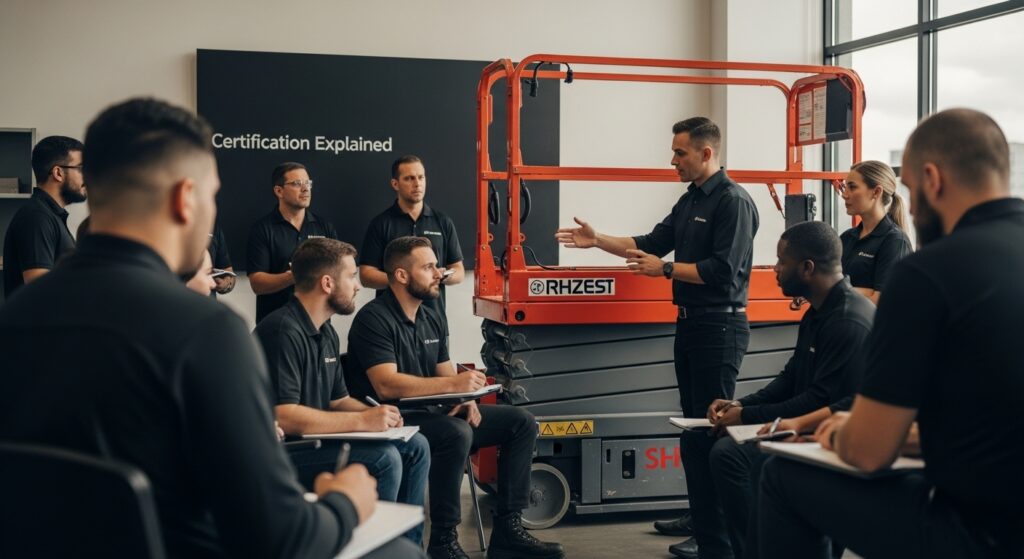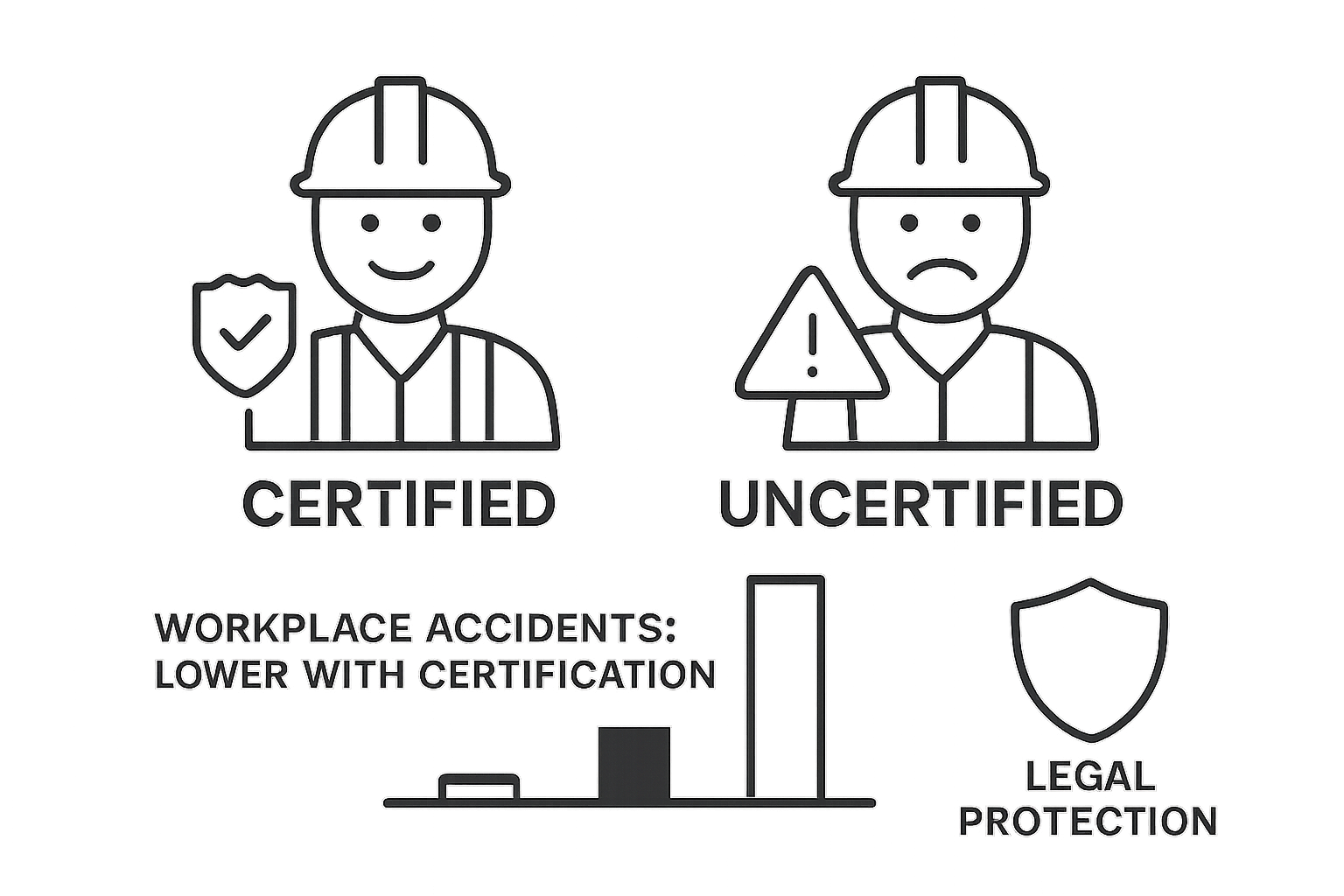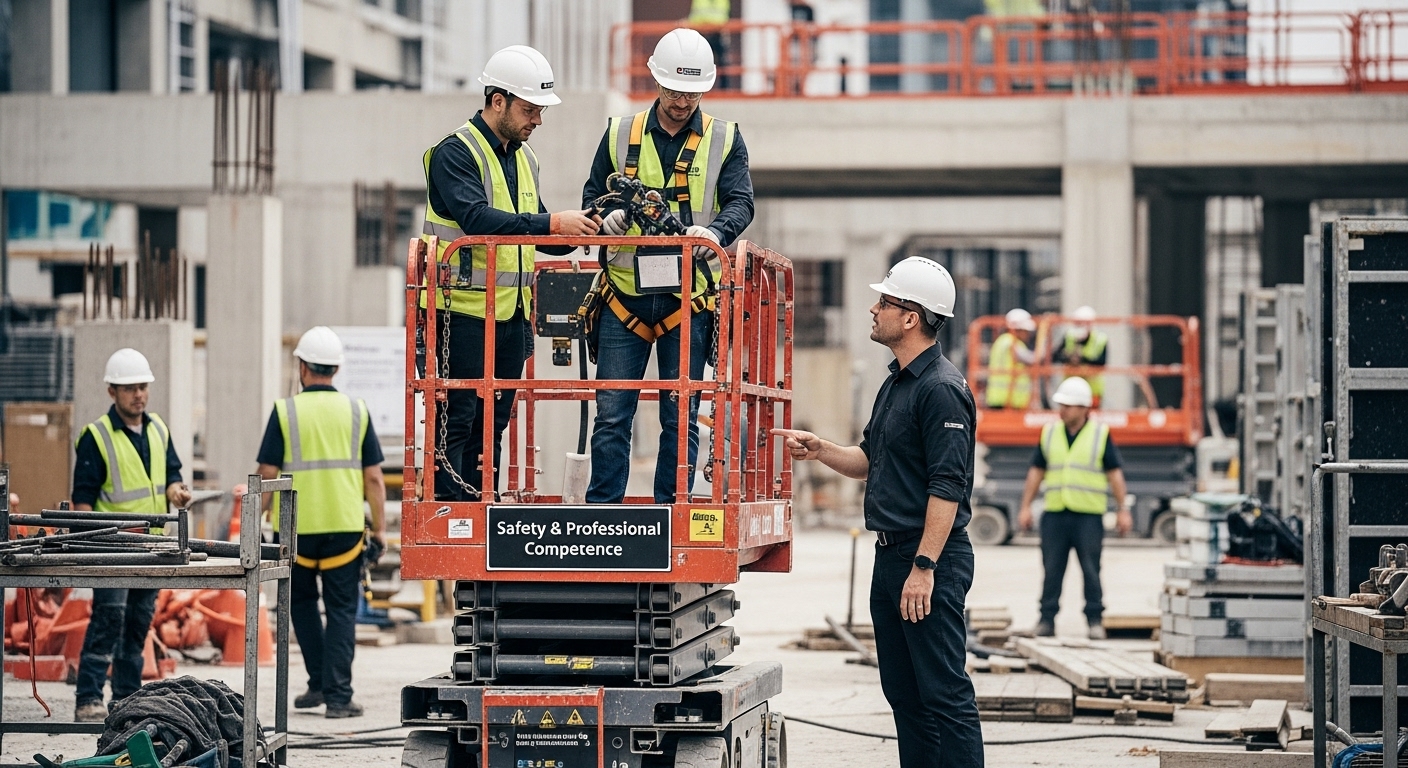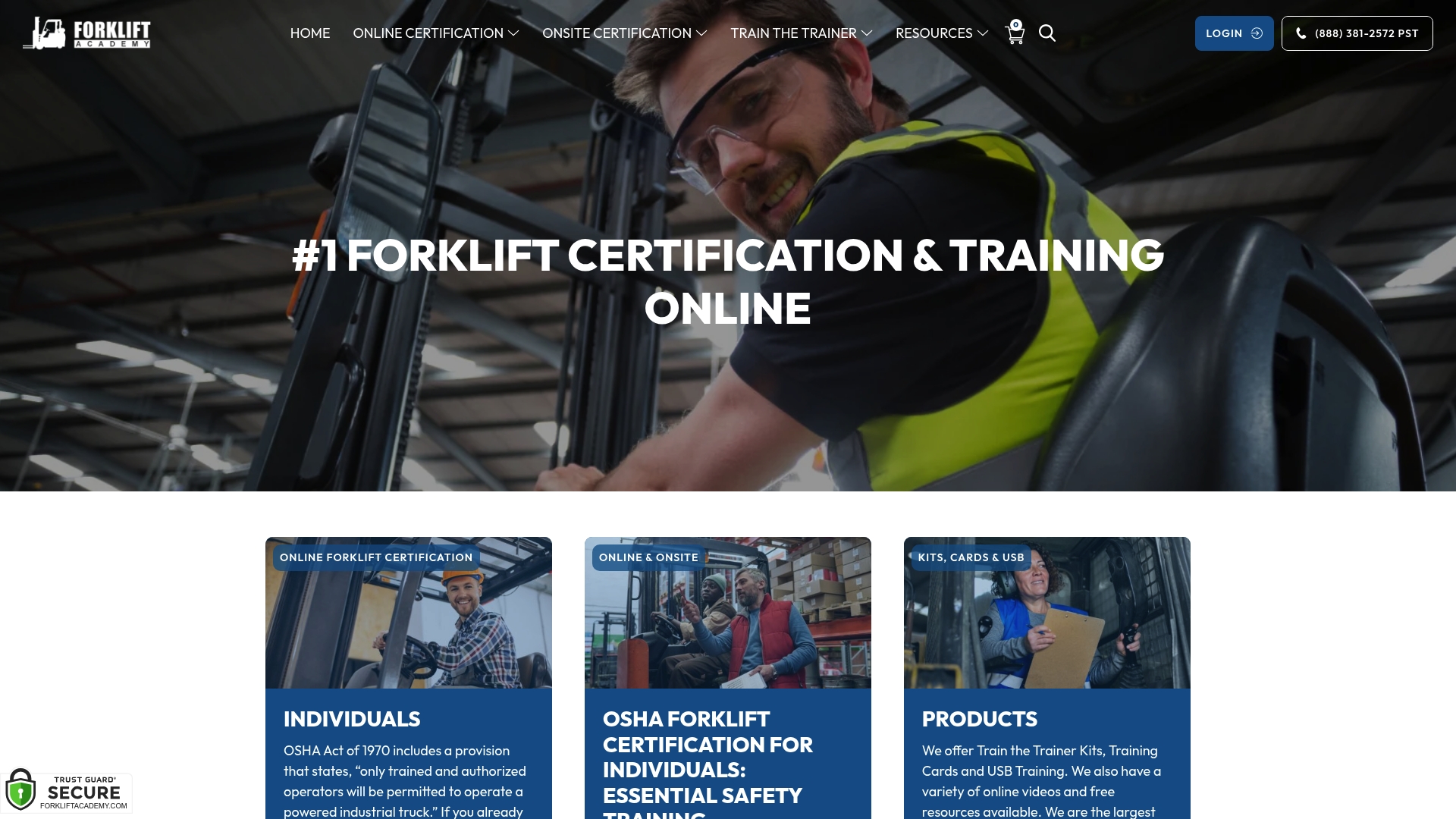
Most people think operating a scissor lift is just a matter of pressing a few buttons and rising up to the job. But the risks are much bigger than they imagine. OSHA reports that improper lift operation is a leading cause of workplace accidents involving serious injuries and even death. The real surprise is that proper certification not only protects workers but also shields companies from crushing penalties and lawsuits.
| Takeaway | Explanation |
|---|---|
| Scissor lift certification is essential for safety. | Certification ensures operators are trained to safely operate equipment, protecting themselves and others in the workplace. |
| Training combines theory and practical evaluation. | The certification process includes classroom instruction and hands-on experience to ensure comprehensive knowledge and skill proficiency. |
| Regular renewal of certification is required. | Operators must renew their certification periodically to stay updated on safety standards and operational practices. |
| Certification reduces workplace accidents and liability. | Proper training minimizes the risk of accidents, reducing legal liabilities and insurance costs for employers. |
| Valuable across various industries. | Certification is crucial in sectors like construction, maintenance, and entertainment, where elevated work is common and safety is paramount. |
Scissor lift certification is a specialized safety training program designed to equip workers with the necessary knowledge and skills to operate scissor lifts safely and effectively in various workplace environments. OSHA mandates that all operators must receive proper training before using these elevated work platforms.
Certification goes beyond simply learning how to control a scissor lift. It represents a comprehensive approach to workplace safety that protects both the operator and surrounding personnel. The primary objectives of scissor lift certification include:
Operators learn critical skills such as pre-operation equipment inspections, understanding load capacities, navigating different surface conditions, and recognizing potential workplace risks. Our comprehensive scissor lift certification training covers these essential aspects to create competent and safety-conscious professionals.
Typically, scissor lift certification involves a structured training program that combines theoretical knowledge with practical hands-on experience. The comprehensive process generally includes:
Participants must demonstrate proficiency in equipment operation, understand OSHA safety regulations, and show the ability to perform safe work practices in various scenarios. Certification is not a one-time event but requires periodic renewal to ensure operators remain updated on the latest safety standards and technological advancements.
Here is a table summarizing the main components and steps involved in the scissor lift certification process, helping readers quickly grasp each stage and its focus.
| Step | Description |
|---|---|
| Theoretical Instruction | Classroom or online learning focused on safety principles and equipment knowledge. |
| Practical Equipment Training | Hands-on practice operating a scissor lift under supervision. |
| Written Examination | Test assessing safety knowledge and regulatory understanding. |
| Skills Demonstration | Evaluation of real equipment operation and safe work practices. |
| Certification Renewal | Ongoing process to update and validate skills and regulatory compliance. |
Scissor lift certification transcends basic training requirements and serves as a critical cornerstone of workplace safety, legal compliance, and professional development. Research from the Bureau of Labor Statistics consistently highlights the importance of proper equipment training in preventing workplace accidents.
Certification provides comprehensive legal and financial safeguards for both employers and employees. Companies that invest in proper scissor lift training protect themselves from potential litigation, substantial financial penalties, and reputational damage. Workplace accidents involving scissor lifts can result in:

Our comprehensive scissor lift training program helps organizations mitigate these risks by ensuring operators understand complex safety protocols and operational standards.
Beyond legal requirements, scissor lift certification demonstrates a commitment to professional excellence and worker safety. Certified operators understand complex equipment mechanics, recognize potential hazards, and can respond effectively to unexpected workplace challenges. Key safety benefits include:
Professional certification signals to employers that an operator possesses the necessary skills, knowledge, and commitment to maintain a safe working environment.
This table compares key safety and legal benefits of scissor lift certification for employers and employees, clarifying how certification supports workplace safety and reduces risks.
| Benefit | For Employers | For Employees |
|---|---|---|
| Reduces Workplace Accidents | Minimizes liability and potential lawsuits | Lowers risk of injury and jobsite incidents |
| Legal Compliance | Avoids OSHA fines and regulatory penalties | Ensures legal right to operate scissor lifts |
| Insurance Cost Reduction | Can lower insurance premiums | Promotes safer working conditions |
| Professional Development | Demonstrates commitment to a safe workplace | Increases job opportunities and skillsets |

Scissor lift certification operates through a structured, comprehensive training process designed to transform novice operators into skilled and safety-conscious professionals. OSHA guidelines establish the fundamental framework for this critical workplace safety training.
The certification process begins with intensive theoretical instruction covering essential safety principles and equipment understanding. Participants engage in detailed classroom or online learning that encompasses:
Learn about our detailed scissor lift training modules to understand the depth of knowledge required for comprehensive certification.
Following theoretical training, operators must demonstrate practical proficiency through hands-on skills assessment. This critical phase involves:
The practical component ensures that operators can translate theoretical knowledge into real-world safe working practices. Instructors meticulously assess each participant’s ability to operate scissor lifts safely, identify potential hazards, and respond appropriately to complex workplace challenges.
Certification typically concludes with a comprehensive written examination and practical skills test, validating the operator’s competence and readiness to work safely with scissor lift equipment.
Understanding scissor lift operation requires comprehensive knowledge of equipment mechanics, safety protocols, and workplace environmental considerations. Research from the National Institute for Occupational Safety and Health highlights the critical importance of proper equipment understanding and safety practices.
Scissor lifts are complex mechanical systems designed to elevate workers safely at various heights. Key operational fundamentals include understanding:
Explore our comprehensive guide to scissor lift safety rules to gain deeper insights into equipment operation principles.
Effective scissor lift operation demands proactive risk management and stringent safety protocols. Critical safety concepts encompass:
Operators must develop a comprehensive understanding of potential workplace risks, including surface conditions, overhead obstacles, electrical hazards, and dynamic environmental factors that could compromise equipment stability and worker safety.
Scissor lift certification demonstrates practical value across multiple industries, transforming workplace safety from theoretical concept to essential operational standard. OSHA regulations underscore the critical importance of specialized training in high-risk work environments.
In industrial and construction settings, scissor lift certification becomes a fundamental requirement for safe and efficient operations. Certified operators play crucial roles in complex work environments that demand precise technical skills and comprehensive safety awareness:
Explore our comprehensive training options for industrial professionals to understand the depth of skills required in these demanding sectors.
Beyond traditional industrial settings, scissor lift certification proves valuable in diverse professional contexts that require elevated work platforms. These specialized environments include:
In each of these environments, certified operators demonstrate not just technical competence, but a commitment to workplace safety and professional excellence. The certification serves as a universal language of competence, allowing professionals to quickly integrate into different work settings while maintaining the highest safety standards.
Are you worried about keeping your team compliant and accident-free when using scissor lifts? After learning how important proper training, OSHA compliance, and hands-on skill evaluation are, it is vital to choose a partner with real expertise. Forklift Academy helps you overcome these worries by simplifying certification and providing trusted, up-to-date solutions. Whether your concern is avoiding costly citations, ensuring operator competence, or managing a safe work environment, our programs are designed for your peace of mind. Discover even more safety resources in our Forklift Safety Archives.

Take the next step toward safer operations today. Tap into more than twenty years of experience with Forklift Academy to get OSHA-compliant training, both online and onsite. Ready to reduce risk, build confidence, and ensure your business meets all legal requirements? Explore our Forklift Certification category to find the training that best fits your team and get certified now.
Scissor lift certification is a safety training program that prepares workers to operate scissor lifts safely. It encompasses theoretical knowledge and practical skills needed to navigate potential hazards in various workplace environments.
Certification is essential for ensuring workplace safety, legal compliance, and professional competence. It helps reduce accident risks, protects companies from legal liabilities, and fosters a culture of safety among employees.
The certification process typically includes theoretical instruction, practical operation training, a written examination, and a skills assessment. Participants must demonstrate proficiency in safe operation and understanding of safety regulations.
Scissor lift certification is not permanent. Renewal is required periodically to ensure that operators stay updated on safety standards and operational practices, usually every three years or as determined by organizational policies.